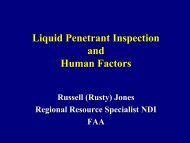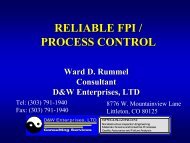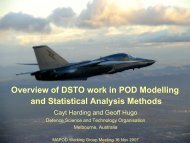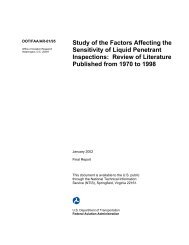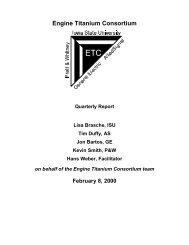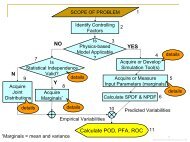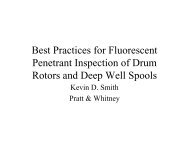Engine Titanium Consortium - Center for Nondestructive Evaluation ...
Engine Titanium Consortium - Center for Nondestructive Evaluation ...
Engine Titanium Consortium - Center for Nondestructive Evaluation ...
Create successful ePaper yourself
Turn your PDF publications into a flip-book with our unique Google optimized e-Paper software.
C2b – Alkaline De-rust Solution B<br />
C5 – Alkaline Gel Cleaner<br />
B1– Plastic media blast (at 80 and 40 psi) <strong>for</strong> 30 sec<br />
• Soot on nickel-based specimens<br />
C3 – Alkaline De-rust Solution A<br />
C7a – Ultrasonic w/Alkaline De-rust Solution B<br />
B1– Plastic media blast (at 80 and 40 psi) <strong>for</strong> 30 sec<br />
• Varnish/Coke on nickel-based specimens<br />
C3 – Alkaline De-rust Solution A<br />
C5 – Alkaline Gel Cleaner<br />
C7a – Ultrasonic w/Alkaline De-rust Solution B<br />
B1– Plastic media blast (40 psi) <strong>for</strong> 30 sec<br />
Visually, almost all of the specimens were evaluated as having a surface that appeared to be clean<br />
following the initial cleaning attempt. At the very least, two out of the three specimens <strong>for</strong> a<br />
particular contaminate/cleaning method combination were assessed as visually clean. However,<br />
crack crevice cleaning as evaluated by brightness was a different story. Many of the specimens<br />
showed reduced brightness with respect to baseline brightness and in some cases no indication<br />
could be discerned either by photometer or by a more sensitive though qualitative visual black light<br />
examination.<br />
The C4 four-step alkaline process <strong>for</strong> nickel-based materials (alkaline rust remover, acidic scale<br />
conditioner, alkaline permanganate, alkaline rust remover) proved successful <strong>for</strong> removing all three<br />
contaminants from the cracks and restoring much of the baseline fluorescent brightness. It was<br />
somewhat less effective on nickel oxidation. However, no cleaning process <strong>for</strong> titanium proved as<br />
effective as the four-step <strong>for</strong> nickel-based materials.<br />
For removal of oxidation on titanium, the cleaning difficulty was partly due to the higher degree of<br />
oxidation with to the nickel-based material. Oxidation on the titanium was estimated to be<br />
equivalent to 5,000 hours of engine run. It represents a heavy amount of oxidation that is now<br />
being seen on some of the hotter running titanium components.<br />
In addition, the method <strong>for</strong> producing soot by suspending specimens, crack opening down, over hot<br />
oil produced a blackened surface having somewhat of a sheen rather than a matte black finish.<br />
This condition would more likely be found on turbine engine hot section parts, but probably not on<br />
titanium cold section parts. The contaminant condition proved more resistant to some of the<br />
cleaning methods than typical soot.<br />
There were sometimes apparent inconsistent results <strong>for</strong> a particular contaminant/cleaning method<br />
that may be related to three different crack sizes being used. That is, perhaps a chemical cleaning<br />
method is more effective at removal of soot on a large, open crack than on a small, tight crack or<br />
Quarterly Report – January 1, 2002 –March 31, 2002<br />
print date/time: 6/6/2002 - 8:39 AM – Page 81



